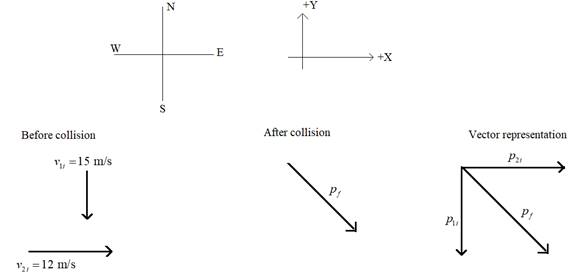
(a)
To Sketch: The situation, assigning coordinate axes and identifying “before” and “after”.
(a)
Explanation of Solution
Introduction:
The situation can be sketched by applying the conservation of momentum and the notation of vectors.
According the conservation of momentum,
Total initial momentum = total final momentum
To sketch the problem showing the states before and after collision, take the y-axis as north and the x-axis as East.
Before the collision, a compact car is shown by a vector which is heading towards the south while the full - sized car is represented by a vector which is heading towards the east.
After the collision, both cars would move as a wreck with a common velocity in southeast direction which is represented by a single vector.

Conclusion:
Hence, the sketch has been drawn.
(b)
To Find: The direction and speed of the wreck.
(b)
Answer to Problem 114A
Explanation of Solution
Given:
Mas of compact car,
Mass of full-sized car,
Initial speed of compact car,
Initial speed of full − sized car,
Formula Used:
Velocity of an object is
Here,
Momentum of the car is given by
Here,
Calculation:
The x-component of the initial momentum of the system will be the sum of the x-components of the momentum of each car. Since the car moving south has no x-component,
Substitute
The y-component of the initial momentum is
Substitute
By the law of conservation of momentum, it can be written as,
And,
Using the vector diagram, it can be written as,
Substitute
The direction of momentum is given by
Substitute
Now, to find the velocity
Substitute
Thus, the wreck at an angle of
Conclusion:
Hence, the wreck is at an angle of
(c)
To Find: The distance travelled by the wreck.
(c)
Answer to Problem 114A
Explanation of Solution
Given:
Coefficient of kinetics friction,
Initial velocity of wreck,
Final velocity of wreck,
Formula Used:
Newton’s second law:
Where,
Friction force:
Where,
Calculation:
Let
The wreck will come to a stop when the fractional force equivalent to the net force acting on it.
Therefore,
Plugging in the given values:
Since, the wreck comes to a stop, Therefore, acceleration would be negative
The distance covered can be determined by using the formula
Plugging in the given values:
Conclusion:
Hence, the wreck skids
Chapter 13 Solutions
Glencoe Physics: Principles and Problems, Student Edition
Additional Science Textbook Solutions
Biology: Life on Earth (11th Edition)
Anatomy & Physiology (6th Edition)
Microbiology: An Introduction
Physics for Scientists and Engineers: A Strategic Approach, Vol. 1 (Chs 1-21) (4th Edition)
Laboratory Experiments in Microbiology (12th Edition) (What's New in Microbiology)
Human Anatomy & Physiology (2nd Edition)
- A pendulum has a 0.4-m-long cord and is given a tangential velocity of 0.2 m/s toward the vertical from a position 0 = 0.3 rad. Part A Determine the equation which describes the angular motion. Express your answer in terms of the variable t. Express coefficients in radians to three significant figures. ΜΕ ΑΣΦ vec (t)=0.3 cos (4.95t) + 0.101 sin (4.95t) Submit Previous Answers Request Answer × Incorrect; Try Again; 6 attempts remainingarrow_forwardPart A ■Review The uniform 150-lb stone (rectangular block) is being turned over on its side by pulling the vertical cable slowly upward until the stone begins to tip. (Figure 1) If it then falls freely (T = 0) from an essentially balanced at-rest position, determine the speed at which the corner A strikes the pad at B. The stone does not slip at its corner C as it falls. Suppose that height of the stone is L = 1.2 ft. Express your answer to three significant figures and include the appropriate units. ? ft VA 10.76 S Submit Previous Answers Request Answer × Incorrect; Try Again; 6 attempts remainingarrow_forwardConsider the circuit shown in the figure. The battery has emf ε = 69 volts and negligible internal resistance. The inductance is L = 0.4 H and the resistances are R 1 = 12 Ω and R 2 = 9.0 Ω. Initially the switch S is open and no currents flow. Then the switch is closed. After leaving the switch closed for a very long time, it is opened again. Just after it is opened, what is the current in R 1?arrow_forward
- A capacitor with a capacitance of C = 5.95×10−5 F is charged by connecting it to a 12.5 −V battery. The capacitor is then disconnected from the battery and connected across an inductor with an inductance of L = 1.55 H . At the time 2.35×10−2 s after the connection to the inductor is made, what is the current in the inductor? At that time, how much electrical energy is stored in the inductor?arrow_forwardCan someone help me with this question. Thanks.arrow_forwardCan someone help me with this question. Thanks.arrow_forward
 College PhysicsPhysicsISBN:9781305952300Author:Raymond A. Serway, Chris VuillePublisher:Cengage Learning
College PhysicsPhysicsISBN:9781305952300Author:Raymond A. Serway, Chris VuillePublisher:Cengage Learning University Physics (14th Edition)PhysicsISBN:9780133969290Author:Hugh D. Young, Roger A. FreedmanPublisher:PEARSON
University Physics (14th Edition)PhysicsISBN:9780133969290Author:Hugh D. Young, Roger A. FreedmanPublisher:PEARSON Introduction To Quantum MechanicsPhysicsISBN:9781107189638Author:Griffiths, David J., Schroeter, Darrell F.Publisher:Cambridge University Press
Introduction To Quantum MechanicsPhysicsISBN:9781107189638Author:Griffiths, David J., Schroeter, Darrell F.Publisher:Cambridge University Press Physics for Scientists and EngineersPhysicsISBN:9781337553278Author:Raymond A. Serway, John W. JewettPublisher:Cengage Learning
Physics for Scientists and EngineersPhysicsISBN:9781337553278Author:Raymond A. Serway, John W. JewettPublisher:Cengage Learning Lecture- Tutorials for Introductory AstronomyPhysicsISBN:9780321820464Author:Edward E. Prather, Tim P. Slater, Jeff P. Adams, Gina BrissendenPublisher:Addison-Wesley
Lecture- Tutorials for Introductory AstronomyPhysicsISBN:9780321820464Author:Edward E. Prather, Tim P. Slater, Jeff P. Adams, Gina BrissendenPublisher:Addison-Wesley College Physics: A Strategic Approach (4th Editio...PhysicsISBN:9780134609034Author:Randall D. Knight (Professor Emeritus), Brian Jones, Stuart FieldPublisher:PEARSON
College Physics: A Strategic Approach (4th Editio...PhysicsISBN:9780134609034Author:Randall D. Knight (Professor Emeritus), Brian Jones, Stuart FieldPublisher:PEARSON





